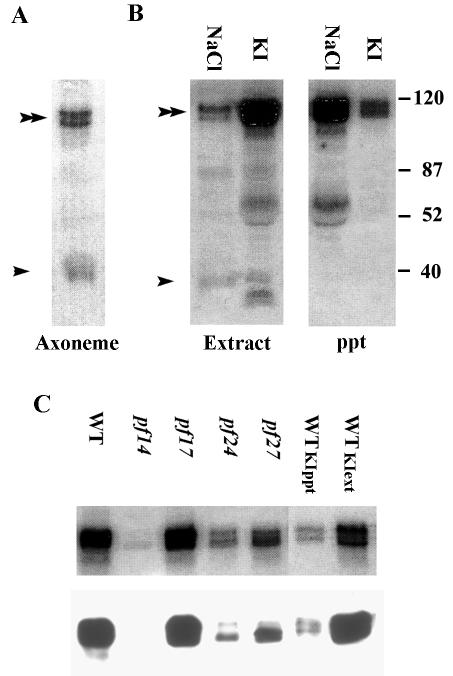FIG. 2.
A 118-kDa candidate axonemal kinase, demonstrated by an in-gel kinase assay, comigrates with RSP2. (A) Prominent bands, revealed by in-gel kinase assay of wild-type axonemes, include a doublet that migrates at 118 kDa (double arrowheads) and a 39-kDa band (single arrowhead) previously determined to be CK1 (62). (B) In contrast to the 39-kDa axonemal CK1, the 118-kDa kinase is not soluble in 0.6 M NaCl but is soluble in 0.6 M KI (compare the KI extract and ppt lanes). (The prominent bands that migrate at about 60 kDa [second and third lanes from left] are likely degradation products of RSP2; in data not shown, the bands are not present in extracts from pf14 axonemes.) Numbers at right are molecular masses in kilodaltons. (C) Axonemal proteins analyzed by in-gel kinase assays (upper panel) and Western blot assays, with an antibody to RSP2 (lower panel), demonstrated comigration of the 118-kDa candidate kinase with RSP2 (wild-type axonemes, lane 1). Both the 118-kDa kinase and RSP2 are missing in axonemes from pf14 (mutant lacking the entire radial spoke) (lane 2), present in axonemes from pf17 (mutant lacking only the radial spoke head) (lane 3), greatly reduced in axonemes from pf24 (mutant with a mutation in the RSP2 gene, expressing only a small amount of RSP2 [see the text]) (lane 4), and reduced in axonemes from pf27 (radial spoke mutant with reduced levels of spoke phosphoproteins [22]) (lane 5). Both the 118-kDa candidate kinase and RSP2 were soluble in 0.6 M KI (compare lanes 6, axonemal ppt, with lane 7, KI extract), similar to the solubility of radial spokes. WT, wild type.

